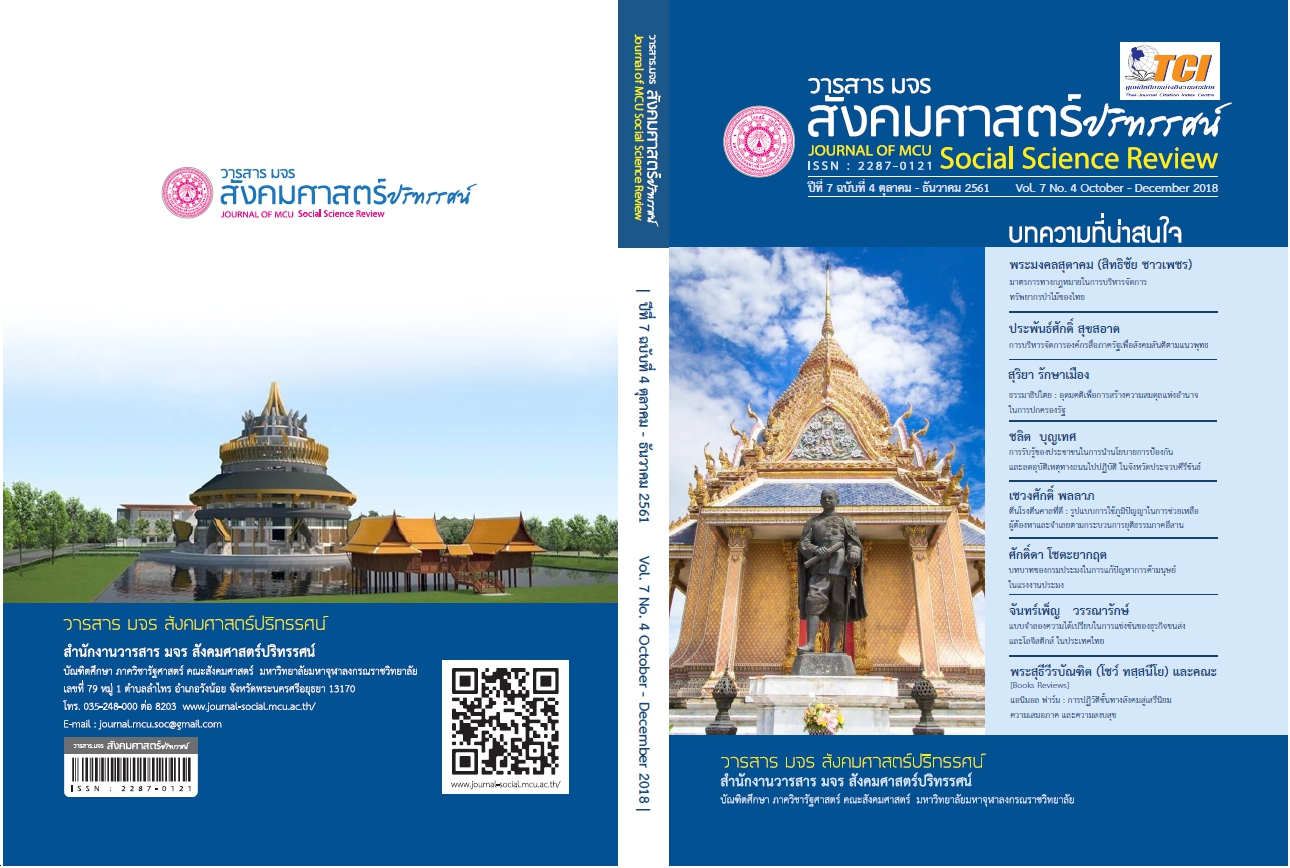บทบาทของกรมประมงในการแก้ปัญหาการค้ามนุษย์ในแรงงานประมง
คำสำคัญ:
บทบาท การค้ามนุษย์ แรงงานประมง แรงงานต่างด้าว ประมงผิดกฎหมายบทคัดย่อ
บทความวิจัยนี้มีวัตถุประสงค์เพื่อศึกษา 1) บทบาทกรมประมงในการแก้ปัญหาการค้ามนุษย์ 2) องค์ประกอบที่มีความสำคัญต่อบทบาทกรมประมงในการแก้ปัญหาการค้ามนุษย์
3) มาตรการและแนวทางในการแก้ปัญหาการค้ามนุษย์ของกรมประมง
ระเบียบวิธีวิจัยเป็นการวิจัยเชิงคุณภาพโดยการศึกษาข้อมูลจากเอกสารและเก็บรวบรวมข้อมูลจากการสัมภาษณ์เชิงลึกผู้ที่มีประสบการณ์ในกิจการประมงจำนวน 27 คนและการสนทนากลุ่ม การวิเคราะห์ข้อมูลใช้วิธีการวิเคราะห์เนื้อหาในรูปของการพรรณนาวิเคราะห์ (Descriptive Analysis)
ผลการวิจัยพบว่า
1) แรงงานต่างด้าวในภาคประมงทะเลเป็นแหล่งที่มีปัญหาการค้ามนุษย์ 2) วิธีการแก้ไขปัญหาการค้ามนุษย์ของรัฐบาลไทยขาดประสิทธิภาพและประสิทธิผลในการบังคับใช้กฎและกฎหมาย ไม่สามารถจะปฏิบัติให้สอดคล้องกับกฎหมายระหว่างประเทศได้ จึงทำให้ไทยถูกสหรัฐอเมริกาจัดประเทศไทยผิดกฎหมายการคุ้มครองเหยื่อการค้ามนุษย์ให้อยู่ในระดับ Tier 3 และมีการทำประมง ที่ผิดกฎหมายจึงได้รับใบเหลืองจากสหภาพยุโรป 3) กฎหมายเกี่ยวกับการบริหารจัดการการทำงานของคนต่างด้าว ไม่มีสภาพบังคับได้จริงที่จะทำให้สอดคล้องกับกฎหมายเกี่ยวกับการประมงระหว่างประเทศ 4) ปัญหาการค้ามนุษย์เป็นผลมาจากการขาดการบูรณาการหน้าที่ของหน่วยงานรัฐ ที่เกี่ยวข้อง และ5) ปัญหาการค้ามนุษย์เป็นผลสืบเนื่องมาจากความโลภทางเศรษฐกิจที่ผู้ประกอบการต้องการลดต้นทุนในการประกอบการ จึงมีการกระทำผิดกฎหมายในทะเล ยากที่เจ้าหน้าที่จะติดตามตรวจสอบ
ข้อเสนอที่สำคัญในการแก้ไขปัญหาการค้ามนุษย์ ดังนี้ 1) กำหนดนโยบายในการบริหารจัดการ ติดตาม ควบคุมเพื่อแก้ไขปัญหาการค้ามนุษย์ในแรงงานประมงให้เป็นไปตามกฎหมาย
2) การแก้ไขปัญหาการค้ามนุษย์อย่างยั่งยืน รัฐบาลควรให้เอกชนผู้ประกอบการมีส่วนร่วมในการแก้ไขปัญหาแรงงานประมง 3) จัดกระบวนการบริหารจัดการแรงงานต่างด้าวในภาคประมงเป็นแบบบริการเบ็ดเสร็จ ณ จุดเดียว 4) กำหนดนโยบายและแผนยุทธศาสตร์บริหารจัดการแรงงานต่างด้าวภาคประมงทะเลในระยะยาว และ 5) พัฒนาความรู้และสร้างความเข้าใจแก่ผู้ประกอบการถึงผลกระทบจากการทำประมงผิดกฎหมายและการค้ามนุษย์ที่นำมาซึ่งความสูญเสียภาพพจน์และความเชื่อมั่นในรัฐบาลไทย
เอกสารอ้างอิง
Boston. J. and Et.Al. (1996). Public Management : The New Zealand Model. Auckland : Oxford University Press.
Dukes,S. (1984). Phenomenological Methodology in the Human Sciences. Journal of Religion and Health,23(3),197 -203.
Osborne, D. and Gaebler, T. (1992) Reinventing Government. New York :Addison-Wesley Publishing Company.
Pearson, Elaine. (2005). Human Trafficking: Redefining Demand. Bangkok: International Labour Organisation.
Raks Thai Foundation. (2003). Tangled Nets: The Vulnerability of Migrant Fishermen and Related Populations In Thailand. Bangkok: Raks Thai Foundation and The Rockefeller Foundation.
Robertson,P..(2010). Labour Right Protection Network –LPN,2009; Mirror Foundation; 2010; UNODC,2010.Bangkok: Mirro Foundation.United Nation.(2011).Human Right. Retrieved On May 5,2017 From Http//:Www.Ohchr.Org/
Documents/Publications/Guidingprinciplebusinesshr_EN.Pdf.
Wannapa Khaopa.(2010). Human Trafficking Getting Worse In Fishing Industry. Bangkok :The Nation. 2010-06-04.
ดาวน์โหลด
เผยแพร่แล้ว
รูปแบบการอ้างอิง
ฉบับ
ประเภทบทความ
สัญญาอนุญาต
ลิขสิทธิ์ (c) 2019 วารสาร มจร สังคมศาสตร์ปริทรรศน์

อนุญาตภายใต้เงื่อนไข Creative Commons Attribution-NonCommercial-NoDerivatives 4.0 International License.
เพื่อให้เป็นไปตามกฎหมายลิขสิทธิ์ ผู้นิพนธ์ทุกท่านต้องลงลายมือชื่อในแบบฟอร์มใบมอบลิขสิทธิ์บทความให้แก่วารสารฯ พร้อมกับบทความต้นฉบับที่ได้แก้ไขครั้งสุดท้าย นอกจากนี้ ผู้นิพนธ์ทุกท่านต้องยืนยันว่าบทความต้นฉบับที่ส่งมาตีพิมพ์นั้น ได้ส่งมาตีพิมพ์เฉพาะในวารสาร มจร สังคมศาสตร์ปริทรรศน์ เพียงแห่งเดียวเท่านั้น หากมีการใช้ภาพหรือตารางหรือเนื้อหาอื่นๆ ของผู้นิพนธ์อื่นที่ปรากฏในสิ่งตีพิมพ์อื่นมาแล้ว ผู้นิพนธ์ต้องขออนุญาตเจ้าของลิขสิทธิ์ก่อน พร้อมทั้งแสดงหนังสือที่ได้รับการยินยอมต่อบรรณาธิการ ก่อนที่บทความจะได้รับการตีพิมพ์ หากไม่เป็นไปตามข้อกำหนดเบื้องต้น ทางวารสารจะถอดบทความของท่านออกโดยไม่มีข้อยกเว้นใดๆ ทั้งสิ้น





